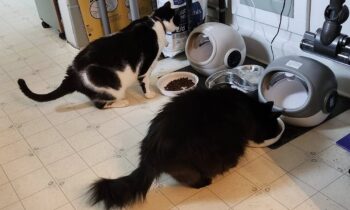
I was wrong. I was so wrong.
Penny is a standard dachshund. It was her first night away from home without her humans. I had put her to bed in her own snuggly blankets in a crate in my bedroom.
Penny had been whining nonstop since she arrived. I fully expected that would continue, and that I would spend a sleepless night.
I was wrong.
Penny did not whine . . . at all. She settled into the cozy kennel without a sound. She didn’t whine, she didn’t bark, she didn’t even snore. I can’t explain it.
I can guess, but can’t know for sure, why Penny’s incessant whining ceased at doggy bedtime after going on for hours. Penny stopped whining, I think, because she recognized the kennel I’d fixed for her as her “home away from home,” primarily because of the familiar bedding her smart humans had brought—security blankets!
I don’t know what Penny’s experience has been with crates. I can say she hesitated only slightly when I invited her to go into the kennel. I did not have to lift her in, pull her, or push her. She walked into the crate on her own. From that behavior, I can guess she might well have had positive experiences with crates in the past. I can feel fairly sure that she’d had few bad experiences with crates—most likely none. And the blankets sealed the deal.
When her family dropped her off, I had asked where Penny normally slept in their home. In their bedroom was the answer—not on the bed, but beside it. For her visit, they had brought her dog bed with its blankets. (As I said, smart.)
Come nighttime, I put the kennel she’d use in my bedroom because that would be most like what she was used to in her own home. Her dog bed was too big to fit inside (and there was no space in the room for a larger kennel), but her familiar blankets fit nicely.
It turned out to be a good choice. Penny was close enough that the other dogs sleeping nearby were visible and audible to her. They spent a quiet night, too, but there was certainly some moving around, both canine and human. I walked by her kennel many times myself.
In the morning, even when the other dogs were waking up, jumping off the bed or coming out of their own kennels, even when I greeted her and let her out of her crate, Penny did not whine—not once! That ‘quiet’ continued through the morning, as the dogs went out, came back in, got treats, drank water, interacted, went upstairs, went downstairs.
No whining.

I didn’t know what to think!
I did know what hadn’t happened: Penny had not suddenly stopped experiencing stress, away from home and her humans, in an unfamiliar place with unfamiliar people and unfamiliar dogs. Her stress had not popped like a bubble just at the witching hour. She was still stressed . . . although I do believe those stress levels were decreasing. The longer she spent with us without having bad experiences, the better—especially if she was actually having good experiences.
The evidence of Penny’s stress continued that day. She wouldn’t take food treats. She didn’t eat meals. (I had checked with Penny’s people about how much she ate and when, and been told that they fed Penny once a day. Often, though, the food sat in her bowl uneaten.) Penny has quite a sturdy figure. It’s clear she gets enough to eat, so I wasn’t concerned about the food refusal. Not eating during the first couple of days a dog is away from home is not unusual.
For the first full day of her visit, Penny hung out primarily in the front hall near the front door, the last place she’d seen her family. I put the dog bed they’d brought for her in that area so Penny could be comfortable, and she chose to be on that bed most of the day when there was nothing else going on. Penny did come upstairs when I was there with some or all of the other dogs, but she stayed only a few minutes, checking everything out, then going back to her post by the front door, waiting.
But still not whining.
In the back yard, Penny showed she was a barker! In winter, it’s easy to see through the fence to the yard behind ours—it has climbing vines in the summer—and my neighbor’s dog, Zoe, was out and Penny could easily see her. Zoe doesn’t come to the fence to interact with dogs she doesn’t know and like, so Penny was doing nothing but a basic alert: “There’s a dog over there!”
(I checked with her humans on their return and, yes, Penny is a barker at home, too. She will usually break it off if one of them steps outside and calls her.) It took me more than one call, I admit, but even with Zoe still out in the next yard, Penny did finally turn and run back to my porch so I could let her inside.
Several more times during her visit, Penny spotted something in the next yard—not always Zoe—that caused her to bark, very loudly, toward the back fence. But her recalls got faster, and I’m very glad to say that I never had to trudge out into the snowy, icy yard to drive her back inside or leash her. I did have the help of the other dogs, of course, setting a good example by running to the back steps with great speed the second I called them. Call it peer pressure or whatever; their response helped.
After another day, Penny decided it was lonely in the front hall. The other dogs and the human were often upstairs, and it sounded as if they might be having fun. She’d come up to ‘check’ on us, then go back downstairs. The ‘checks’ lasted longer and longer. I realized at one point that I hadn’t heard her go back downstairs, so I looked to see where she was. Penny was in the crate I’d brought up for her, snuggled in her cozy blankets, fast asleep. She continued to choose that safe spot to hang out for the remainder of her visit—in the same room with the rest of us.
Then she started eating. Treats, at first, and only tiny pieces; she’d take a treat between her lips, walk a few steps, then drop the treat on the floor, where she’d snuffle it and, usually, walk away without eating it . . . until she started eating every treat I gave her!
I suspected she was finally getting hungry. Whatever stress was causing her not to eat was being pushed aside as a concern because of her empty stomach. That night, I put her bowl down, she stuck her head in it, and she did not raise her head until all the kibble was gone. From that point on, she ate everything she was offered.
It was clear: although Penny was still in an unfamiliar place with unfamiliar dogs and humans, she was becoming more and more comfortable with the situation. She made choices that demonstrated she was starting to feel safe with us. She relaxed. She ate and drank. She interacted with the other dogs, inside and outside. She wagged and even barked—but she did not whine.
Instead, soon, she chose to communicate.
One particular time, I watched Penny ‘demonstrate’ what she wanted, showing in every way possible that she wanted to get up on the bed, where the other dogs were hanging out. She came over to the side of the bed where I was sitting. She persisted until I made eye contact with her. She wagged her tail and looked . . . well, ‘hopeful’ would be a good word. She did not vocalize. She was, in fact, quiet, happily wiggling. She asked to get up on the bed.
I patted the bed and indicated she could hop up.
She didn’t hesitate. Penny hopped up gleefully!
She gave a great sigh and flopped down against my leg.
She didn’t move while I picked up my laptop and went back to work. She stayed still until I put the laptop aside and started scratching her ears. Shortly after that, she rolled over so I could scratch her tummy. I’m sure she would be in that position today if we could’ve managed it. Penny was happy.
Did she ever whine again?
You bet she did. She whined like a maniac when her humans arrived!
She jumped up on them with great excitement, whining and bouncing and wildly wagging. She whined loudly the entire time we discussed her visit. It was hard to hear the other humans! I noticed that none of us reprimanded her. It wasn’t possible to praise her for quiet, the method I described last week using on Penny when she first arrived. There was no quiet. I guess she took a breath or two, but she snuck it in so fast, there was no way I could mark it.
Penny had not been ‘cured’ of whining—not even by praising her for quiet. Penny still could and would whine.
No matter how little she might do it as she’s getting used to a given situation, her whining will likely reoccur when the situation changes. Eliminating the whining entirely might be possible through ongoing work, but it would take a great deal of time, ingenuity, and patience on the part of the humans involved. Would that effort be worth it?
I can’t answer for her humans. I think it’s likely that the whining isn’t a constant issue in their home. Or, if it is a constant issue, they’ve gotten so used to it that it doesn’t bother them much . . . or they’ve chosen to live with it even though it’s annoying. For them, the whining is part of the whole package that is the dog they love—a small enough part that they tolerate it with grace.
I do have a theory.
I think Penny can communicate quite well with humans once they actually make eye contact. I saw that in my experience with her ‘communicating’ her wish to be up on my bed with the other dogs.
What was the prerequisite for that clear communication? First, she had to get my attention. And Penny is short.
It’s possible that her whining acts as an audible bike flag, a doggy back-up beeper, a way to attract attention so that she can express her needs. Penny could easily pass by an adult human without being noticed if the human is standing or even sitting but not looking down. Penny, silent, might be too easy to ignore.
When being close physically wasn’t working for Penny, maybe that’s how the whining snuck in? She stands at your feet but you don’t notice. She whines and you pay attention? Behavior that is rewarded will continue: your attention rewards her whining.
How to turn that around?
Whining might be reduced by paying close attention to the dog when she is not whining. Make it easier for her to communicate. Notice her in the room, make eye contact, give her a chance to initiate a conversation, if you will.
Maybe even come up with a cue for asking Is there anything you need right now? Catch the eye of the dog, make that exaggerated body posture of asking a question, say something like “What’s up?”
Will the dog take you to the treat jar?
Or maybe to the door to go outside?
She might ask to get up on the bed!
Whining is communication . . . but the sound itself can be so annoying. It’s not a behavior that can be eliminated by intimidation or pain. Punishment will only make it worse.
Instead, set your dog up for success by praising for quiet and by consciously offering frequent opportunities for your dog to communicate without whining. For short dogs, make eye contact and ask, “What’s up?”



